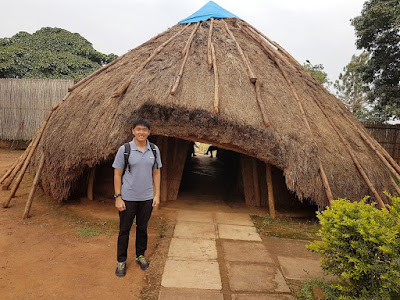JPN: Kushida Shrine
1-41 Kamikawabatamachi, Hakata, Fukuoka, Japan
Daily: 4.00am - 10.00pm
Daily: 4.00am - 10.00pm
Kushida Shrine is a tutelary Shinto shrine in Fukuoka, Japan that was founded in 757. It's dedicated to Amaterasu, the goddess of the sun and the universe, and Susanoo, the god of the sea and storms. A local summer festival called Hakata Gion Yamakasa is centred on this particular shrine.
---
JPN: Hotel Sunline Fukuoka Hakata Ekimae
JPN: Nagahama Fish Market Centre
JPN: Korokan Ruins Museum
JPN: Maizuru Park
JPN: Ohori Park
JPN: Kushida Shrine <YOU ARE HERE!>
JPN: Tocho-ji & Shofuku-ji
JPN: Fukuoka Downtown
JPN: Fukuoka Uptown
JPN: Yufuin No Mori 3
JPN: Tenku Yubo Seikaiso
JPN: Seven Hells of Beppu (Part 1)
JPN: Seven Hells of Beppu (Part 2)
JPN: Beppu Downtown
JPN: Yufuin Kotobuki Hananosho
JPN: Yunotsubo Street
JPN: Kinrin Lake
JPN: Yufuin Downtown
JPN: Hotel Route-Inn Kumamoto Ekimae
JPN: Kumamoto Castle
JPN: Kumamon Square
JPN: Kumamoto Downtown
JPN: Tsubame 322 & Huis Ten Bosch 11
JPN: Hotel Okura JR Huis Ten Bosch
JPN: Town of Sasebo
JPN: Mameshiba Café
JPN: Huis Ten Bosch (Part 1)
JPN: Huis Ten Bosch (Part 2)
JPN: Nagahama Fish Market Centre
JPN: Korokan Ruins Museum
JPN: Maizuru Park
JPN: Ohori Park
JPN: Kushida Shrine <YOU ARE HERE!>
JPN: Tocho-ji & Shofuku-ji
JPN: Fukuoka Downtown
JPN: Fukuoka Uptown
JPN: Yufuin No Mori 3
JPN: Tenku Yubo Seikaiso
JPN: Seven Hells of Beppu (Part 1)
JPN: Seven Hells of Beppu (Part 2)
JPN: Beppu Downtown
JPN: Yufuin Kotobuki Hananosho
JPN: Yunotsubo Street
JPN: Kinrin Lake
JPN: Yufuin Downtown
JPN: Hotel Route-Inn Kumamoto Ekimae
JPN: Kumamoto Castle
JPN: Kumamon Square
JPN: Kumamoto Downtown
JPN: Tsubame 322 & Huis Ten Bosch 11
JPN: Hotel Okura JR Huis Ten Bosch
JPN: Town of Sasebo
JPN: Mameshiba Café
JPN: Huis Ten Bosch (Part 1)
JPN: Huis Ten Bosch (Part 2)
---
I visited the shrine in the evening after dinner. There weren't many people around, save for one section.
Toyotomi Hideyoshi, one of Japan's 'great unifier', made it a point to contribute to the rebuild of the main shrine in 1585 to what we see today.
Omikuji (Japanese fortune-telling papers) costs ¥100 (~S$1.25) each. As I've already drawn a good fortune in Tokyo in March last year, I decided not to get another one in December. Anyway, when the office is open, you can ask for an information sheet about the shrine in English.


 |
| Enjoying the rather mystical atmosphere~ |
 |
| I really have no idea what those people were queueing for. They paid some money and entered the building. If someone can enlighten me, I'd be truly grateful. |
An interesting sight seen at the grounds of the shrine is kakiyama, one of the big-sized floats that's approximately one tonne in weight. During the Hakata Gion Yamakasa festival held from 1 to 15 July every year, participants race through the town carrying those heavy floats.
 |
| Designated as an Important Intangible Folk Cultural Property of Japan in 1979, the festival is believed to be over 700 years old |
 |
| Top-notch conservation efforts till date, I must say! |
 |
| Legend has it that drinking the water from that well in front of the main shrine grants eternal youth and longevity. |
 |
| Should you draw a bad fortune, fold up and hang that strip of paper on a metal wire. |
Have you ever written any prayers or wishes on an ema (lit. picture-horse) before? It's named so as people used to donate horses to shrines for good favour in ancient times. Over time, the practice evolved to using wooden plaques with pictures of horses and eventually to the ones with various designs that we have today.
There are a few sub-shrines there.
 |
| Those successive shrine gates immediately reminded me of Fushimi Inari Taisha in Kyoto. |
 |
| The short path leads to a dead end. |


 |
| I really enjoyed the serenity of the place. |
When you happen to be around between end of January and early February, you can pass through the mouth of the biggest Otafuku mask in Japan, measuring 5.3 metres in height and 5 metres in width, for good luck. Otafuku is a well-known figure of a plump-faced woman in Japanese folklore.

















Comments
Post a Comment